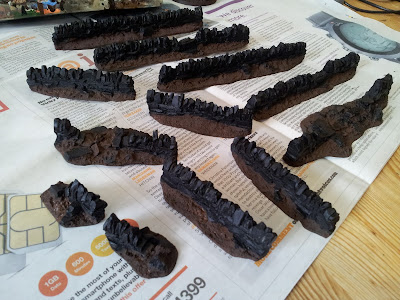We'll return to the medieval tavern again later, but I thought I'd break things up a bit and do another terrain piece. I wanted a small piece of terrain that I could use on my wargaming board to add a bit of tactical variation to the gameplay. Approached from one side, it was to have some difficult terrain, and a small cliff to be scaled. But approached from the other, a smooth rise to the cliff edge, ideal for a row of archers to hail death and metal down on the approaching hordes.
The base is 10mm styrofoam, A4 size base, with two smaller pieces of 10mm styrofoam layered up to create a ridge. I angled off the edges with my hotwire cutter, and cast a piece of plaster of paris in my cliff face mould (it comes with the woodland scenics 'rock faces' learning kit
http://www.antenocitisworkshop.com/lk951-rock-faces-learning-kit.html). The 'foundations' are completed by pva gluing on some bits of broken up cork. This is just normal cork from a bottle, peeled apart by hand, and it shreds into beautiful rocky lumps. As long as you glue the smooth outside bit of the cork facing down so it can't be seen, you get very realistic boulders. I made a line of boulders along the ridge of the plaster of paris rock outcropping, to blend the edge of the join, and then scattered a few boulders around the base of the cliff. I've also pva glued down a scattering of sand (I made this before I bought my fine-ground cork for texturing - sand creates a finer texture, but weighs a bit more). Now it looks like this:

Then once the pva is all completely dry, the next job is to undercoat the whole thing to seal it all together. I didn't use my chaos black spray because the propellant in the spray dissolves the styrofoam and you end up with a cratered moonscape. Not ideal. This is brush-painted, using an undercoat paint I bought from forgedinblood, an ebay seller I have mentioned on a previous blog page. He's the one who gives all his scatterpacks evocative names like 'elf havens' and 'orc scrubland'. His undercoat paint is exactly the same. This isn't 'dark brown acrylic undercoat' - it's 'bugbear bile'. Go figure. Still, it's a good undercoat, and takes the paint nicely, but slightly less matt than the GW chaos black.

I painted the whole thing with an earth brown basecoat, and painted the rocks and boulders with a mid-grey basecoat, and drybrushed with a light grey to pull out all the details. Here it is after I'd glued on some mossy scatter and some silflor grass tufts. These come stuck on a sheet of clear plastic film, and you peel off the ones you want and glue them down with pva as usual. They're quick and easy and make great little reed clumps.
After gluing on the static grass (I made this before I bought my static grass applicator) and some bits of brown lichen for shrubs. I've also added some ground-trailing plants across the outcropping. This is a very fine dark green scatter poured over lines of pva glue painted on with a medium fine brush.

Next I've added some long grass clumps (I'll do a page about making the long grass another time) and a couple more different ground scatters. I've also glued some leaf scatter onto the bush that's growing up against the outcropping. I don't use pva glue for this - I use scattergrip. I can recommend this glue for glueing scatter onto lichen or suchlike. It is a very tacky glue, and even when it's dried, it stays tacky, so it's ideal for this kind of application. You paint it onto the bush, and leave it for about 5 minutes for it to start going tacky. Then you scatter on your leaf scatter, and it grabs it straight away. You have to treat these pieces with a bit of care - if you brush your hand (or other item) heavily against the bush, or bang the piece hard, the bush will shed leaves.
Here's Frodo and Sam looking out over the edge of the cliff. Looks far too green to be the Emyn Muil or Mordor, but Sam's still ready for action.
Here's another shot of the piece, taken outdoors under cloudy sunlight. I think the natural light improves the realism.















































